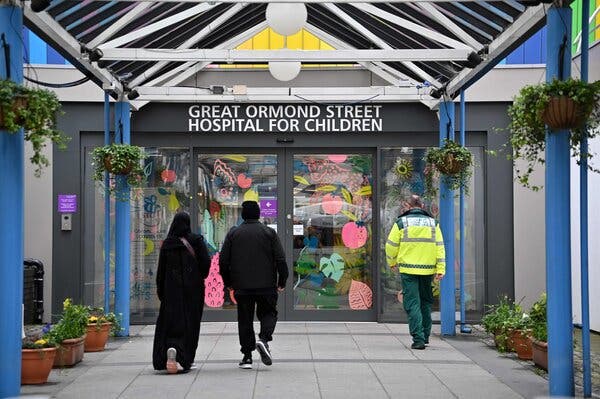Advertisement
Supported by
Children With Covid Inflammatory Syndrome May Overcome Their Most Serious Symptoms
A small study found that six months after hospitalization, most children with MIS-C did not have debilitating health issues. But some had lingering muscle weakness and emotional difficulties.

Children who get sick from the rare but serious Covid-related inflammatory syndrome may surmount their most significant symptoms within six months, but they may still have muscle weakness and emotional difficulties at that time, a new small study suggests.
Published in the journal Lancet Child and Adolescent Health on Monday, the study appears to be the first detailed look at the health status of children six months after they were hospitalized with the condition, called Multisystem Inflammatory Syndrome in Children. The syndrome typically emerges two weeks to six weeks after a Covid-19 infection that is often quite mild, and it can result in hospitalizations for children with severe symptoms involving the heart and several other organs.
A major question has been whether children who survive MIS-C will end up with lasting organ damage or other health problems. The new study, of 46 children under 18 who were admitted to a London hospital for MIS-C (it has a different name and abbreviation, PIMS-TS, in Britain), suggests that many of the most serious problems can resolve with time.
“To be honest, I think we all didn’t know what to expect,” said Dr. Justin Penner, a pediatric infectious disease physician at the hospital involved in the study, Great Ormond Street Hospital, known as GOSH. “We didn’t know which body systems would require assistance or become a problem one month, three months, six months down the line.”
The children in the study were hospitalized between April 4 and Sept. 1, 2020, part of the first wave of the inflammatory syndrome. Many were quite sick. They all had systemic inflammation, and most had symptoms involving multiple organ systems, such as the heart, kidneys or circulatory system. Forty-five children had gastrointestinal symptoms, and 24 had neurological symptoms such as confusion, memory problems, hallucinations, headaches or problems with balance or muscle control.
Sixteen of the children were placed on ventilators, 22 needed medication to help their hearts pump more effectively and 40 were treated with immunotherapies like intravenous immunoglobulin. All survived.
Six months after they were discharged from the hospital, only one child still had systemic inflammation, just two children had heart abnormalities and six children had gastrointestinal symptoms. All but one child were able to resume school, either virtually or in person.
Still, 18 of the children were experiencing muscle weakness and fatigue, scoring in the bottom 3 percent for their age and sex on the six-minute walking test, a standard test of endurance and aerobic capacity. And 15 children were experiencing emotional difficulties like anxiety or severe mood changes, according to questionnaires answered by either the parents or the children.
In the United States, 3,742 young people age 20 and under have developed the syndrome, and 35 have died, according to the most recent data from the Centers for Disease Control and Prevention. A major study of long-term outcomes has already recruited 600 children and will follow them for five years, according to a leader of that effort, Dr. Jane Newburger, associate chief for academic affairs in the cardiology department at Boston Children’s Hospital.
Dr. Newburger, who was not involved in the British report, called it a “small but important study” that “contributes new information to the knowledge gap about long-term effects of MIS-C.”
She and the authors themselves noted that there were limitations to the findings because the children in the study were not compared with a control group of children without MIS-C or those with other illnesses. It is unclear, for example, if their emotional problems and muscle weakness were the result of the syndrome, the process of being hospitalized for an illness or other stressors during this time. “Mental health and physical conditioning have taken a hit in children and adolescents in general during the pandemic,” Dr. Newburger said.
Dr. Srinivas Murthy, an associate professor of pediatrics at the University of British Columbia, who was not involved in the new study, said it might be difficult to tease out which residual problems were directly attributable to the syndrome and which might have resulted from any critical illness. He said the fact that some of the children still had trouble with muscle weakness and endurance could yield important lessons, because such issues can require a different kind of a care including “post-hospitalization rehabilitation opportunities.”
In fact, Dr. Penner said, the team at Great Ormond Street Hospital has made changes in the treatment of children hospitalized with the syndrome since the fall, because it has recognized “how affected their muscles are at the onset and how profoundly fatigued and weakened these kids are.”
In the hospital, for example, “often just transferring from the bed to the toilet is exceptionally difficult for these children,” he said.
The hospital now has a more concerted focus on providing the children in-hospital physical therapy and work with musculoskeletal therapists, he said, and it sends them home with an individualized rehabilitation plan that is linked to an app.
“We’ve also involved our occupational therapists, and we’ve developed a fatigue program that’s run once a month where the parents dial in for a group session,” Dr. Penner said. “I think the main message that we give them is to avoid this boom-and-bust cycle, where the kids try to do the things they used to do at full speed and then they kind of crash afterwards — as opposed to a gradual increase of activity back to their normal state.”
The hospital’s team is continuing to follow the children’s health. One potential concern is whether kidney or gastrointestinal problems might emerge later, which can occur after other critical illnesses, the study’s authors wrote. The team also hopes to conduct neurocognitive evaluations and other neurological testing, Dr. Penner said.
“We don’t know what the longer-term outcomes will be,” Dr. Penner said. But for now, he added, “being able to relay at least what we’ve seen so far to parents has really enabled us to alleviate some of their anxieties about this black box of unknowns with regard to this new condition.”
Advertisement

